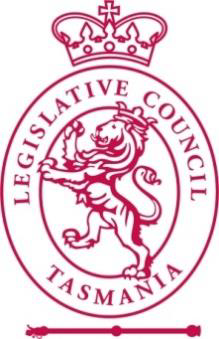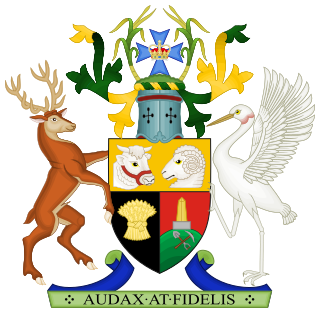Electoral systems of the Australian states and territories are broadly similar to the electoral system used in federal elections in Australia.

The House of Assembly, or Lower House, is one of the two chambers of the Parliament of Tasmania in Australia. The other is the Legislative Council or Upper House. It sits in Parliament House in the state capital, Hobart.

The Tasmanian Legislative Council is the upper house of the Parliament of Tasmania in Australia. It is one of the two chambers of the Parliament, the other being the House of Assembly. Both houses sit in Parliament House in the state capital, Hobart. Members of the Legislative Council are often referred to as MLCs.

In Australia, electoral districts for the Australian House of Representatives are called divisions or more commonly referred to as electorates or seats. There are currently 151 single-member electorates for the Australian House of Representatives.

The Division of Franklin is an Australian electoral division in Tasmania.

The Legislative Assembly of Queensland is the sole chamber of the unicameral Parliament of Queensland established under the Constitution of Queensland. Elections are held every four years and are done by full preferential voting. The Assembly has 93 members, who have used the letters MP after their names since 2000.
This is a list of the members of the Australian House of Representatives in the First Australian Parliament, which was elected on 29 and 30 March 1901. There were 75 members, as required by the Constitution, as near as possible to twice the number of Senators which was then 36. South Australia and Tasmania had not been divided into electoral divisions in 1901 which resulted in the particular state voting as a single electorate. There were seven members for South Australia, and five members for Tasmania elected.

Donald Norman Cameron was an Australian politician. He served in the House of Representatives and Tasmanian House of Assembly.

The 1901 Australian federal election for the inaugural Parliament of Australia was held in Australia on Friday 29 March and Saturday 30 March 1901. The elections followed Federation and the establishment of the Commonwealth of Australia on 1 January 1901. All 75 seats in the Australian House of Representatives, six of which were uncontested, as well as all 36 seats in the Australian Senate, were up for election.

The 1903 Australian federal election was held in Australia on 16 December 1903. All 75 seats in the House of Representatives, and 19 of the 36 seats in the Senate were up for election. The incumbent Protectionist Party minority government led by Prime Minister Alfred Deakin retained the most House of Representatives seats of the three parties and retained government with the parliamentary support of the Labour Party led by Chris Watson. The Free Trade Party led by George Reid remained in opposition.
The lower houses of the parliaments of the states and territories of Australia are divided into electoral districts. Most electoral districts send a single member to a state or territory's parliament using the preferential method of voting. The area of a state electoral district is dependent upon the Electoral Acts in the various states and vary in area between them. At present, there are 409 state electoral districts in Australia.
The 1909 Tasmanian state election was held on Friday, 30 April 1909 in the Australian state of Tasmania to elect 30 members of the Tasmanian House of Assembly. This was the first general election in the British Empire to elect all members through a form of proportional representation, the single transferable vote.
The Division of South Australia was an Australian electoral division covering South Australia. The seven-member statewide seat existed from the inaugural 1901 election until the 1903 election. Each elector cast seven votes. Unlike most of the other states, South Australia had not been split into individual single-member electorates. The other exception was the five-member Division of Tasmania. The statewide seats were abolished at a redistribution conducted two months prior to the 1903 election and were subsequently replaced with single-member divisions, one per displaced member, with each elector now casting a single vote.
This article provides information on candidates who stood for the 1901 Australian federal election. The election was held on 29/30 March 1901.
This article provides information on candidates who stood for the 1903 Australian federal election. The election was held on 16 December 1903.

The 2008 United States presidential election in Nebraska took place on November 4, 2008, as part of the 2008 United States presidential election. Voters chose five electors to the Electoral College, who voted for president and vice president. However, Nebraska is one of the two states of the U.S. that, instead of giving all of its electors to the winner based on its statewide results, allocates just two electoral votes to the winner of the statewide popular vote. The other three electors vote based on their individual congressional district results.
The Division of Tasmania in Australia was created in 1901 and abolished in 1903.
The following tables show state-by-state results in the Australian Senate at the 1901 federal election. Senators total 17 Free Trade, 11 Protectionist, and eight Labour. The terms were deemed to start on 1 January 1901. In each state, the first three elected received full six-year terms, and the three senators elected with the lowest number of votes retire after three years.

Chanter v Blackwood and the related case of Maloney v McEacharn were a series of decisions of the High Court of Australia, sitting as the Court of Disputed Returns arising from the 1903 federal election for the seats of Riverina and Melbourne in the House of Representatives. Chanter v Blackwood , and Maloney v McEacharn , determined questions of law as to the validity of certain votes. In Chanter v Blackwood Griffith CJ held that 91 votes were invalid and because this exceeded the majority, the election was void, while Chanter v Blackwood dealt with questions of costs. In Maloney v McEacharn more than 300 votes were found to be invalid and the parties agreed it was appropriate for the election to be declared void.
The Australian states each elected three members of the Australian Senate at the 1910 federal election to serve a six-year term starting on 1 July 1910.
This page is based on this
Wikipedia article Text is available under the
CC BY-SA 4.0 license; additional terms may apply.
Images, videos and audio are available under their respective licenses.















